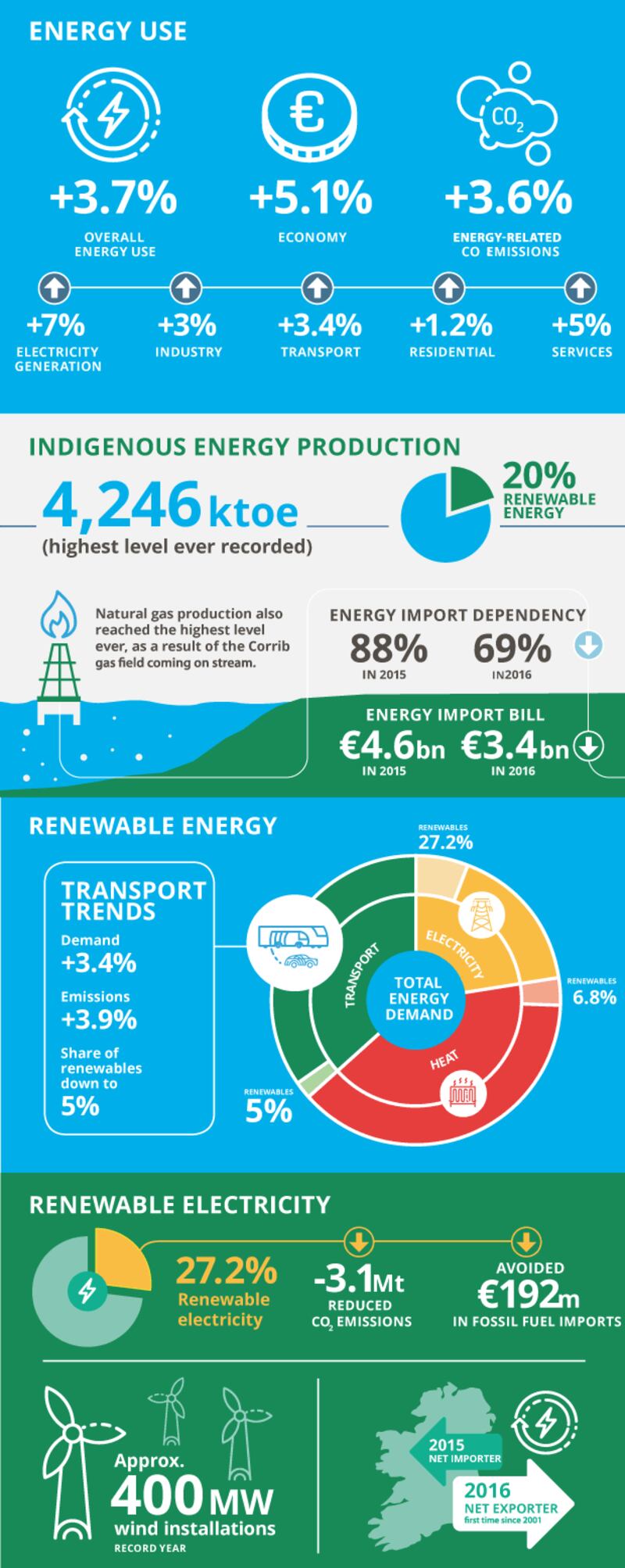Ireland became an exporter of electricity last year on the back of record production from onshore and offshore windfarms, and this year's production could be even higher, a new report shows.
And the country's spending on imported fossil fuels fell by €1.2 billion last year following the opening of the often-controversial Corrib gas field off the Mayo coast.
A report from Sustainable Energy Authority of Ireland (SEAI), due to be published on Tuesday, highlights major changes in where Ireland’s energy comes from, and how it is now being consumed.

Ireland produced its largest amount of renewable electricity ever last year, on the back of the introduction of an additional 400 megawatts of power from wind turbines.
This brought the total capacity of Ireland's wind turbines, on land and at sea, to 2,827 megawatts, according to the SEAI's annual Energy in Ireland Report. It includes analysis going back to 1990.
Most of the turbines that entered service last year did so towards the end of last year, so this year’s figures should be higher again, the report says. In addition, the more windy conditions seen this year will also boost production.
Renewable electricity generation accounted for more than 27 per cent gross electricity consumption in 2016, while the use of renewables in electricity generation reduced CO2 emissions by 3.1 million tonnes and avoided €192 million of fossil fuel imports.
Natural gas production reached its highest level ever in 2016 following the entry of supplies from the Corrib gasfield off the Mayo coast into the system.
Last year, Ireland bought 69 per cent of its fossil energy supplies from abroad, compared with 88 per cent in 2015. Consequently, the “energy import bill” for Ireland fell from €4.6 billion in 2015 to €3.4 billion.
The SEAI analysis shows the Irish economy grew by 5 per cent last year, while energy use grew by 3.7 per cent. CO2 energy emissions grew by 3.6 per cent, though Irish renewables cut CO2 emissions by 3.9 million tonnes.
Decarbonising
The significant savings to be made from energy conservation by homes and businesses makes the case for adopting renewable energy and decarbonising now "undeniable", said SEAI chief executive Jim Gannon.
The 2016 data shows encouraging trends, he said, including a continued decoupling of economic growth and energy use.
“However, the pace of this divergence is too slow and is simply not sustainable,” Mr Gannon said.
A growing economy powered by a low fossil fuel price remained a barrier to the shift to a sustainable energy future, he added.
“Encouraging decision-makers to act is all the harder without the price signals to drive investment in sustainable energy technologies and practice.”
Transport remains a challenge, consuming 42 per cent of all energy use last year, though Mr Gannon said people are now beginning to look seriously at electric vehicles.
Next year, SEAI will promote the use of electric vehicles by public and private users by making them available for a year on a trial basis, extending the home charger network and supporting car-sharing in towns and cities.
The average emissions of new Irish cars bought last year was 112.4 grammes of carbon dioxide per kilometre, down considerably since changes to motor taxation that targeted high emitters were introduced.
More than three quarters of all new private cars purchased so far this year are ranked as A label, while 94 per cent of new houses built between 2015 and 2017 are also ranked in the highest category.
The European Union has set a more demanding target of 95 grammes of carbon dioxide per kilometre for new cars from 2020, though the question of how diesel manufacturers will deal with particulate emissions has yet to be agreed.
Concern is growing that Ireland will face fines for missing EU carbon dioxide targets by 2020, Mr Gannon acknowledged. But Ireland, he said, must get on with trying to “get to 2020 in the best possible shape and in setting platforms for 2030”.









